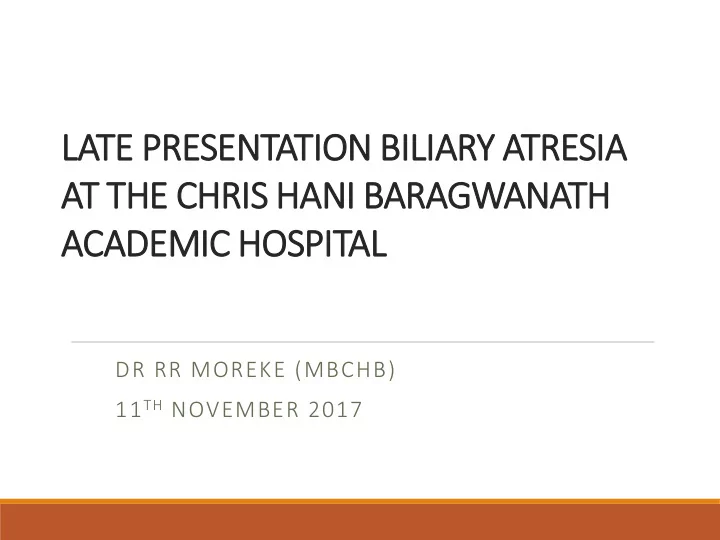

LATE PRESENTATION BILIARY ATRESIA AT THE CHRIS HANI BARAGWANATH ACADEMIC HOSPITAL DR RR MOREKE (MBCHB) 11 TH NOVEMBER 2017
INTRODUCTION Biliary atresia(BA) is a destructive inflammatory obliterative cholangiopathy of neonates Affects varying lengths of both intra-hepatic and extra-hepatic bile ducts If untreated, progressive liver cirrhosis leads to death by age 2 years Incidence: Taiwan 1 in 5000 o UK & France 1 in 17000-19000 o RSA (Soweto) 1 in 2500-8000 (1993-6) There’s no primary medical treatment relevant in the management of BA Surgical intervention is the only modality available for definitive diagnosis (intra- operative cholangiogram) and therapy(Kasai porto-enterostomy (KPE))
INTRODUCTION CONT… Several factors affect success of surgery including: o Age at surgery: better if patients aged <60 days o Extend of liver damage/fibrosis o Experience of the Medical Centre/centralization of care etc Many patients are still presenting to hospital >3 months of age and prognosis of KPE in these, is generally poor In our resource scarce setting, where liver transplantation is only available in a minority of patients, its imperative that we diagnose BA and refer our patients for KPE early
OBJECTIVES Determine the total number of patients with BA seen at CHBAH from Jan 2010 - Dec 2015 Determine the number of late presentations Identify factors contributing to late referral and/or presentation Document management of late presenters Document outcome of the late presenters
STUDY DESIGN Retrospective, descriptive study Sample population ◦ All patients seen at CHBAH, by Paediatric Gastroenterology Hepatology and Nutrition Unit (PGHNU) between Jan 2010 and Dec 2015 ◦ Data collected from PGHNU database ◦ Medical records were reviewed Inclusion and exclusion criteria Data analysis (percentages, median and interquartile ranges, p values calculated for relevant parameters) Late presentation for this study: defined as age ≥ 90 days at presentation
RESULTS A total of 122 patients were seen during study period 102 fulfilled the criteria for inclusion 53 patients presented at ≤89 days (52%) 49 presented at ≥90 days ( 48%)
DEMOGRAPHIC DATA Age At Presentation Age (in All patients (102) Early (≤90days) Late (≥90days) days) Median (IQR) Median (IQR) Median (IQR) 82 days 52 days 172 days (51.0 ;166.0) (36.0 ;68.0) (193.5 ;119.5) SEX All patients < 90 days > 90 days P Values M (n) 42 25 17 F (n) 60 28 32 0.28 M:F 1 : 1.43 1:1.12 1: 1.88
Place of residence PROVINCE Total <90 days >90 days P values Gauteng 76 44 32 Other 25 9 16 0.09 province Other 1 0 1 country
FACTORS CONTRIBUTING TO DELAY IN PRESENTATION Number of Factors Reasons for late presentation patients Delay in presentation :normal 41 RHT 1 (admission/transfer/surgery/liver biopsy) Parental Defaulted FU - 2 PHC 4 - 1 DHS - 1 THS Failure to ever present to PHC 6 Ongoing data Preference for traditional medication collection False reassurance “normal” 12 Primary Health Care Clinics Stool/urine documented not checked 3 (Presumed rest not checked either) FU given but defaulted - 1 DHS 3 - 2 PHS Misdiagnosis 3 (sepsis, breast milk jaundice) Failure to refer to hospital 40
FACTORS CONTRIBUTING TO DELAY IN PRESENTATION Number of Factors Reasons for late presentation patients Failure to investigate 1 District hospital Failure to act on blood results 1 services Delay due to unnecessary investigations 0 No FU 1 Misdiagnosis (sepsis) 1 Failure to refer to a THS 2 Liver biopsy inconclusive 0 Tertiary hospital services Delay in surgery (>13 days of admission) -lack of expertise/limited resources(time, operating 2 theaters) No FU 0 Misdiagnosis 1 (UTI) Failure to refer for surgery 1 (UTI)
Education & Social circumstances Maternal education Early Late (highest level achieved) Basic education 8 12 (Grade 12 or less) Basic degree 1 2 Diploma 1 0 Place of residence Early Late Informal (shack) 4 4 RDP 2 2 House 7 11
MANAGEMENT OF LATE PRESENTERS Management Total numbers % of total LP KPE Total 10 * 10/49 -20.4% Functioning 2** (20%) Partially functioning 4 (40%) Non functioning 3 (30%) Demised post op 1 (10%) (biliary leak and sepsis) Lap only, no KPE 2 2/49 - 4.1% 49 49/49 -100% Liver biopsy Referred 6 (no KPE) Transplant 6/49 -12.2% Transplanted LRDT 1 On active list 1 Worked up awaiting to be 1 listed Demised while on active list 3
OUTCOMES OF THE LATE PRESENTERS (up to 31 st January 2017) % of total late Outcomes Total numbers presenters Alive 8 (2 functioning KPE**) 16.3% Demised 17 34.7% Referred to private 2 4.1% Lost to follow up 15 30.6% No FU 7 14.3%
CONCLUSION A significant number of patients with BA (48%) presented late for management KPE was offered to only a small number of the late presenters but was in most cases not successful The majority of late presenters progressed to portal hypertension and ultimately demised Liver transplantation is only accessible to a small number of patients In a resource poor society KPE can be used to bridge the gap until transplantation is required
CONCLUSION CONT… Factors for delay in presentation and diagnosis were identified at all levels of health care The study emphasizes the importance of educating the community and all health care professionals of the necessity for early identification and referral of a cholestatic child Parental education about the condition appears to be lacking but due to inadequate data, could not correlate with educational/ social status of parents Emphasis should be placed on educating staff at PHC clinics- lectures, educational posters, management algorithms or stool colour charts in the RTHB
FUTURE We hope the study will: ◦ Improve awareness of BA ◦ Encourage screening for BA ◦ SASPGHAN- ideal platform to engage with the department of health at national level to implement new strategies for diagnosis and management of BA ◦ Screening ◦ Creating SA BA Registry ◦ Liver transplantation support
THANK YOU: DR HAJINICOLAOU
Recommend
More recommend